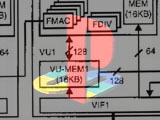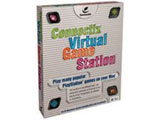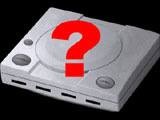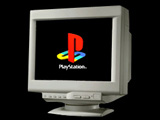

|
Wednesday, February 17th, 1999 |
PSX2: 55 Million PPS Nope. That isn't a misprint, and you aren't seeing things. The latest article
from PSX.IGN.COM is titled
"Under the Hood of PlayStation 2".
What's so special about it? Well, lets take a look:
Nope. That isn't a misprint, and you aren't seeing things. The latest article
from PSX.IGN.COM is titled
"Under the Hood of PlayStation 2".
What's so special about it? Well, lets take a look:
Director Masakazu Suzuoki discussed the tech specs of two chips that would work with "high-end consumer electronics such as games and network applications." While not a word was actually spoken about what these applications might be, Suzuoki consistently referred to previous generations of "videogame machines" in his half-hour speech. And when asked if this was the processor to Sony's next gaming system, he offered a polite "no comment" to attendees of the session. We all winked and played along. What we saw today was significant stuff. And the meeting opened wide the floodgates for a flurry of new speculations on the capabilities of "PlayStation 2." While most of the information offered about the system's chipsets were for engineers' ears, we were certainly listening when the chipset's few real-world features were announced. According to Suzuoki, this processor will feature both a CPU (central processing unit) and a Floating-Point Unit (FPU), as well as two Vector Processor Units (VPU0 and VPU1). The CPU will run at a brisk 250 MHz with a 2 GB per second bus bandwidth. All right, before your eyes begin to glaze over, here is the real meat of the conference: The 3D capabilities: Without lighting effects, 55 million polygons per second. With lighting effects, 32 million polygons per second. With lighting and fog effects, 30 million polygons per second. With Bezier surfacing, 13 million polygons per second. In true gaming numbers, the polygon count may be significantly lower, since these figures don't take into account texture maps, character artificial intelligence, physics models, or any other processor-intensive instructions. But in relative terms, the Dreamcast can only handle 6 million polygons per second without effects, and the latest figures on the Voodoo 3 only clock the card at around 9 million. "Bezier surfacing" is a powerful set of instructions used by professional CG renderers. Without getting too technical, developers can construct models using Bezier surfacing, and the instructions will build the model using as many or as few polygons as it sees fit to use. There are more benefits to using the technique, and we'll be explaining Bezier surfacing in more detail tomorrow. The other interesting tidbit is the processor's MPEG2 decompression capabilities. According to Suzuoki, half of the CPU power is available while it is decompressing MPEG2 information. While no examples were offered, what this means is DVD quality full motion video can be played on top of, or along with, a realtime 3D world. At the conclusion of the hour-long presentation, Phil Harrison, vice president of third party and R&D for SCEA, and Andrew House, vice president of marketing for SCEA, were seen exiting the hall. They both offered a "no comment" regarding what these chipsets were for. In Japan this March, Sony may remove the veils from the company's next console gaming system, and this conference is only a taste of the information that will soon be heading our way. In short, keep watching this space, gang. It's only going to get more interesting. |
|
Saturday, February 13th, 1999 |
|
Ad in GamePro The first ever advertisement for the console versions of Quake II is in this month's issue of GamePro Magazine. The box art is the same for both games (with the difference being the box/case setup, ofcourse). The cover is the player aiming a Grenade launcher at a Tank. The ad had the following text:
We ripped its heart out and strapped it into new bodies. Faster, fiercer and more powerful than ever comes Quake II for PlayStation game console and Nintendo 64. These totally redesigned versions are born again with uncharted levels, ideal graphics, blood-curdling sound effects, ferocious 2/4 player DeathMatches and Dual Shock feedback literallly give you one intense out-of-body experience. Quake II for the console - Welcome to the next life. |
|
Sunday, February 7th, 1999 |
Connectix Wins In a legal shocker, Sony's lawsuit against Connectix did not go through.
As you know, Connectix is the company that made the PSX Emulator for Apple
Macintosh computers. Here's the story from IGNPSX:
In a legal shocker, Sony's lawsuit against Connectix did not go through.
As you know, Connectix is the company that made the PSX Emulator for Apple
Macintosh computers. Here's the story from IGNPSX:
After a phone call today to Connectix, it appeared the spirit of David (from the Biblical tale of David and Goliath) was running strong through the company's veins. "Our approach is to prepare for all contingencies," said Roy McDonald, president and CEO of Connectix Corporation. "We think that the merits of the case are in our favor. [We] believe our pioneering emulation technology gives consumers more choice in the hardware they use to run popular software applications." The injunction process is just the beginning of what may appear to be a long, drawn out battle in which Sony believes the intellectual rights of the PlayStation have been broken. It's likely Sony will take the next step of bringing the case to court. When asked what he thought Sony's next step would be, McDonald replied: "My presumption is that they'll prepare their own statement. I saw an article in the SF Chronicle this morning in which Molly Smith spoke about the case, and she said that this is just the first step in a long process. All I can say is that the matters will be better discussed out of courtroom and in a boardroom with each interested party on the same level." The Connectix Virtual Game Station, which debuted at MacWorld in January, is a software emulator that permits PlayStation games to be played on an Apple iMac and G3 series computers. The product is surprisingly deft, and works with dozens of games, ranging from Crash Bandicoot: Warped, Metal Gear Solid, and NFL Madden 99, to name a few. At an estimated MSRP of $49, the Virtual Game Station is available in many on-line stores, including www.connectix.com, as well as through major Macintosh resellers. "What I have yet to see is a tangible scenario in which Sony doesn't benefit, or in which it's hurt by our product or products like ours," explained McDonald. "I don't see any scenario so far that demonstrates that point." A new update to the Virtual Game Station, version 1.1, is now available for download from Connectix's website. Version 1.1 features improved game compatibility over the original Version 1.0 and enhanced anti game-piracy technology. It also introduces a novel Auto Launcher mode that launches compatible PlayStation games as soon as they are inserted into the Mac's CD drive. "Connectix Virtual Game Station gives Macintosh owners more games to choose from and PlayStation owners more choice in where they play their games, and we will continue to fight for the customer's right to this choice. We have offered this type of ability successfully and without controversy for years in the PC emulation market and intend to defend the consumer's right to this functionality in the PlayStation market space as well. "We've shipped more than 10,000 and less than 50,000. But early customer response to the new Version 1.1 has been overwhelmingly positive, and we are glad that we are going to be able to continue our shipments to fill our enormous backlog of orders. If we had 50,000 or thereabouts we could ship them all right now. This is not unusual for us. Utilities from Connectix have shipped very much like this in the past. This product certainly seems to have the momentum to ship as past product." Although a phone call was placed to Sony Computer Entertainment America, no representatives were able to return our phone calls prior to today's deadline. |
|
Monday, February 1st, 1999 |
|
Quake 2 in PlayStation Power Quake II is the cover story of the latest issue of "PlayStation Power" magazine. The U.K. based mag had the largest feature on Quake II in print yet. The preview had nothing but positive remarks. From the screenshots I saw, the game easily rivals the PC version of Quake II running on a Voodoo 1 card. The colored lighting was fantastic, and all of the textures were very smooth. The only noticeable difference between this and Voodoo based PC is the lower resolution and frame rate. But, when you're playing on a 27" TV, isn't it worth it? Between this preview and the announcement of the game delay for multiplayer purposes (which is a good thing), Quake II on the PlayStation appears to shaping up better than anyone imagined. This spring can't come fast enough. This magazine can be found at Tower Records or any other place that sells foreign magazines. Trust me, it's worth looking for. |
| Saturday, January 30th, 1999 |
|
id Speaks On Game Delay Appearantly, I dumped good old Blue in "shark infested waters" when I sent him the story about the PSX Quake II delay. Needless to say, Todd Hollenshead, CEO of id Software, e-mailed Blue with some familiar info:
|
| Thursday, January 28th, 1999 |
|
Quake II Delayed!!!!! After several days of rumors being circulated around the 'net, PSX.IGN.COM has reported that Quake II for the Sony PlayStation is in fact being delayed. The major cause appears to be the problems presented by the four player deathmatch. Here's the article:
Originally scheduled for a December 1998 release date, the game was then shifted to February/March 1999. Now, apparently, Activision has said officially that Quake II, in development with UK-based Hammerhead Studios, will arrive this spring, which translates into the May/June slot. Although the Nintendo 64 version is being shown around, the PSX version isn't, and though no reason was given as to its delay, the four-person death match mode looks to be the biggest delay. What's our opinion? Damn! Bring it out! Hurry! Hopefully, the wait is worth it. |
| Friday, January 22nd, 1999 |
|
Changes As you may have heard, Quake2.com is shutting down as a site to make way for Q3Arena.com. However, Quake2.com is still around as a hosting service. This means that QuakeStation is fine for right now. The Quake2.com staff has no plans to either sell or shut down the domain name. So rest assured, QuakeStation is still in full operation. |
| Tuesday, January 19th, 1999 |
|
Quake 2 Down Under There is a half-page article in the January issue of "Official Australian PlayStation Magazine". The article describes the basic information known about the game, and includes some screen shots as well. Thanks to "FreakNek" for the news tip. Unreal Denied by Epic PSX.IGN.COM has reported that Epic has officially denied the existence of Unreal on Sony PlayStation. This isn't very surprising to many, as Unreal has huge system requirements on the PC and a PlayStation version would be difficult. However, the game may still be in development. If this is the case, than Epic is only denying it because they haven't made an official press release yet. |
| Friday, January 15th, 1999 |
|
Unreal on PlayStation It looks like Quake II may get some competition as the best First Person Shooter on Sony PlayStation. According to PlanetUnreal, Unreal will be released for PlayStation before the end of this year:
GT Interactive will roll out its Unreal mega-hit to Sony PlayStation owners in the autumn. Conversion outfit Aardvark has undertaken the ambitious port for what could be one of the biggest PlayStation hits for 1999. "There is yet to be a first-person game on the PlatSyation that has lived up to expectations" said Paul Fox for GTI. "The release of Unreal on the PlayStation will be all the more significant, arriving as it does while the memory of the original benchmark title remains fresh." |
| Tuesday, January 12th, 1999 |
PlayStation 1.5 PSX.IGN.COM has blew the cover on
Sony's top secret new system: "PlayStation 1.5". Sony has had the idea of releasing
a "beefed-up" PlayStation for quite some time, but it appears that their concept is
finally starting to take shape:
PSX.IGN.COM has blew the cover on
Sony's top secret new system: "PlayStation 1.5". Sony has had the idea of releasing
a "beefed-up" PlayStation for quite some time, but it appears that their concept is
finally starting to take shape:
Talk of a "PlayStation 1.5" has been echoing in the industry for almost two years, but from what IGNPSX has learned recently, it is anything but speculation, and is, at least somewhere deep inside Sony's hardware research facilities, a bona fide reality. But what exactly is it? According to those who have seen the silicon up-and-running, it isn't anything earth-shattering, but would have the potential to increase PlayStation's viability nonetheless. Here's what's hiding under its hood, according to our sources: Compatibility with existing PlayStation software is obviously the crux of this hardware, although the possibility of games designed specifically for use on it (i.e.: Game Boy Color) cannot be ruled out entirely. Those who have seen the hardware tell IGNPSX that it offers the user two modes of operation, "enhanced" (provides all of the keen new effects) and "compatibility" (for those who want to play their games as they appear on an original PlayStation). Now for the big question what does this mean for PlayStation as we know it? Given the fact that, as it stands, there is no indication that games would be made that can only run on this new hardware, it isn't likely that current PlayStation owners would be given the shaft by Sony. On the other hand, those who bought a system days or weeks in advance of the "step two's" introduction might feel like they've received the short end of the stick. And while the system would no doubt split the market to some extent, it would admittedly be a good tactic to keep current (and future) PlayStation owners to stick with the Playstation brand, something that Sony is obviously very keen on doing. We say "would" because, according to our developer sources, Sony is still divided as to whether it should even release this new flavor of PlayStation in any territory, and is no doubt waiting to see how PlayStation 2 is shaping up or rather, as our sources convey, not shaping up before making a final decision. There's even the chance that the hardware may only reach market as an add-in for other multimedia devices, much in the same way that VMLabs' NUON technology will be included in some DVD players introduced later this year. The idea of this system is not completely negative, though. Imagine the possibilites with PSX Quake II:
|
| Saturday, January 9th, 1999 |
|
The Connectix Saga Two big things happened at the MacWorld expo this week. One is Quake related, the other is PlayStation related. The Quake news? The very first video of Quake III Arena in action was released. The PlayStation news? You guessed it: The Mac PlayStation emulator from Connectix. Since the announcement of this emulator, PSX.IGN.COM has secured two interviews with Connectix. Part one discusses how Connectix believes that they can't be sued by Sony. Part two discusses exactly how the emualtor works. And last but not least, PlayStation MAX reports that Sony is indeed going to sue Connectix. There's a shocker. More Screenshots There are 7 screenshots of Quake II on PlayStation up at Videogames.com. Due to the poor quality of the images, I will not be posting them in the screen shots section. They are still worth checking out, though, as they show some of the different environments in the game. |
| Wednesday, January 6th, 1999 |
PSX Emulation PSX.IGN.COM has a new article up
regarding emualtation, titled PlayStation Emulation goes mainstream.
The article discusses how the company "Connectix" is bringing a PSX emulator to
the Macintosh computer format (of all things!). Using the emulator and PlayStation
games on it will require a Macintosh equipped with a G3 processor. Here's the lowdown:
PSX.IGN.COM has a new article up
regarding emualtation, titled PlayStation Emulation goes mainstream.
The article discusses how the company "Connectix" is bringing a PSX emulator to
the Macintosh computer format (of all things!). Using the emulator and PlayStation
games on it will require a Macintosh equipped with a G3 processor. Here's the lowdown:
Designed specifically for use on G3-powered Macintosh systems, including Apple's hot new iMac, CVGS has premiered at $49.95 and is currently available only at Macworld Expo; a full retail release is expected shortly, though no firm date can be given. It should be noted, however, that Connectix does not recommend that the software be used in conjunction with older Macs that have been upgraded with G3 proccessors. IGNPSX has the opportunity to test the software on a base-model G3 setup comparable in performance to an iMac, and the results were quite impressive to say the least. CVGS runs an astonishingly large list of both older and current games, including Crash Bandicoot: Warped, Metal Gear Solid, Gran Turismo, Final Fantasy VII, and Tenchu. All of the games suffered marginal frame-rate drops on our test system, but did boast full 2D/3D support, sound support, and their full motion video sequences played back flawlessly. Unlike comparable emulators currently under development for PC-compatible systems, though, CVGS does not make use of Glide (or comparable) APIs to perform filtering or other effects in 3D games. In short, they looked, sounded, and played just like they did on a real PlayStation, albeit a bit slower. Owners of faster Macintosh G3 systems, should enjoy near-flawless emulation, however. The possibilities introduced by the emulator are vast, and many Mac pundits have already been quick to tout them. One obvious advantage involves the ability to run CVGS on G3-powered Powerbook laptops; the idea of playing PlayStation games while on the road, on a plane, or pretty much anywhere a real PlayStation can't go is incredibly intriguing. Furthermore, buzz out of Macworld Expo suggests that Apple may even work a deal to bundle the emulator with future iMac systems. So what does Sony Computer Entertainment have to say about all this? For the moment, it is offering a stern no comment. Connectix representatives have stressed that the emulation was achieved entirely through perfectly legal reverse engineering, and, from we've seen, Sony's proprietary PlayStation BIOS (Basic Integrated Operating System) was not used. IGNPSX will attempt to further clarify Sony's stance on the emulator (which is unlikely to be very sunny) in the coming days. In the meantime, we'll have a further look at CVGS later this week, and will hopefully be able to nail down any plans Connectix may have for a PC-compatible port of the software. |
| Friday, January 1st, 1999 - Happy New Year! |
|
Hammerhead Interview There is another interview with Hammerhead Software up at PSX.IGN.COM. This is the second interview that PSX.IGN.COM has done with Hammerhead. Here are the highlights:
New For '99 Several changes/additions have been made to QuakeStation to ring in the new year! Here's what's up:
QuakeStation IRC QuakeStation now has it's own IRC channel! For instructions on how to join in on the fun, check out the IRC instructions page. See you on IRC! |